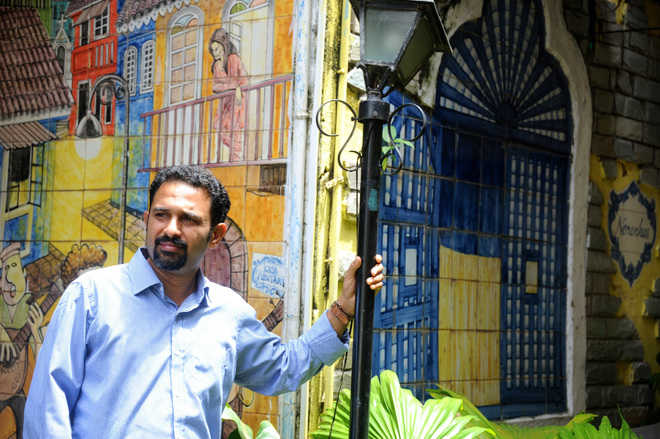Every azulejo tells a story
Preeti Verma Lal
Azulejo. To say this Portuguese word, you’ll have to twist your tongue and keep ‘j’ silent. It is not so simple, though. The Spanish pronounce it ah-soo-le-haw, the Portuguese, ah-zoo-le-zhoo. Do not blame the word. For it borrows from three languages (Portuguese, Spanish and Arabic). The word origin is a mish-mash, not this art of painting on ceramic tiles which originated in the 15th century Portugal and travelled to India when the Portuguese settled in Goa.
So, azulejos are painted ceramic tiles? No. These are hand-painted. These incredibly beautiful tiles are created over hours — clay and water mixed into a dough, spread on a tray, cut to size, dried and fired in a kiln. It is, then, glazed with powdered glass.
When the tile is ready, drawings are transferred from a tracing paper by sprinkling the perforations with powdered charcoal. Or, drawn straight on the tile and painted. The paint used in azulejos is made of glass powder and oxides and does not fade with time. Dinnerware paint is different; the oxide colours of azulejos are toxic. Poisonous, actually. The tile with finished painting is fired again at 1,050 ºC to fuse the glaze, definitively setting the painting. It is, then, soaked in water. And lo! The arty azulejos are ready.
In India, these tiles are made only in Goa. Interestingly, during the Portuguese reign, there were no Goan azulejos artists. These were imported from Portugal. The Portuguese came with the azulejos; the Portuguese went back with azulejos. Their departure almost killed the art — and market — of hand-painted tiles in India.
Then, the art returned to Goa. With Orlando de Noronha, a man with a five-year degree in commercial art from Goa Art College. Orlando went to Lisbon (Portugal) to hone his guitar skills and returned home after two years with a bagful of azulejos. That excess baggage was to change Orlando’s fate and with him, the fate of Goan azulejos. In the beginning, he was hesitant about azulejos as his mainstay but one opportunity led to another and gradually Goa woke up to the forgotten art. In his studio in Panjim, the walls are cluttered with azulejos with Mario Miranda’s famous cartoons. Orlando has been doing Miranda’s drawings on tiles for nearly a decade which have found takers across the world.
Miranda’s caricatures sure are the favourite azulejo design but these are not the only one. The common motifs include Goan fisherwoman, toddy tappers, ferries, boats, kunbi dance, bhatkar, churches, taverns, rural life, among others.
Azulejos, which were almost forgotten, are now everywhere in Goa. Artists have embraced the art and buyers/patrons are loosening their purse-strings. Walk around Goa and azulejos almost seem like a part of the Goan landscape. In railways stations and shops. In homes and hotels. As murals and nameplates. As wall decor and sidewalks. As style and as statement. Each azulejo tells a story. A Goan story.










